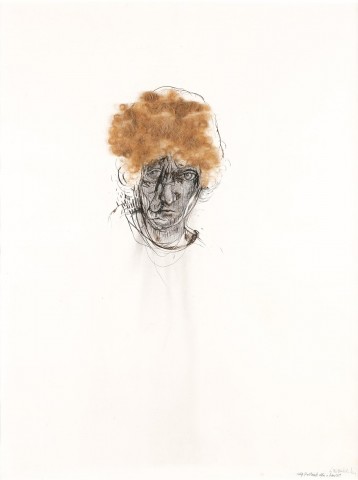SELF PORTRAIT AFTER A HAIRCUT AT 36, 1976
BRETT WHITELEY
pen and ink and hair on paper
100.0 x 75.0 cm
signed and inscribed with title lower right: brett whiteley / self-portrait after a haircut at 36
Australian Galleries, Melbourne
Private collection, Melbourne, acquired from the above in 1994
Thence by descent
Private collection, Sydney
Brett Whiteley, Australian Galleries, Melbourne, 21 September – 5 October 1976, cat. 22 (illus. in exhibition catalogue)
Brett Whiteley: Art & Life, Art Gallery of New South Wales, Sydney 16 September – 19 November 1995; Museum and Art Gallery of the Northern Territory, Darwin, 13 December 1995 – 28 January 1996; Art Gallery of Western Australia, Perth, 22 February – 8 April 1996; Art Gallery of South Australia, Adelaide, 9 May – 16 June 1996; National Gallery of Victoria, Melbourne, 2 July – 26 August 1996; Tasmanian Museum and Art Gallery, Hobart, 18 September – 17 November 1996
McGrath, S., Brett Whiteley, Bay Books, Sydney, 1979, cat. 84, pp. 103 (illus.), 226 (illus., as ‘Self Portait with Real Hair’)
Pearce, B., Brett Whiteley: Art & Life, Thames and Hudson in association with the Art Gallery of New South Wales, Sydney, 1995, pl. 118 (illus.), p. 233
Sutherland, K., Brett Whiteley: Catalogue Raisonné: 1955-1992, Schwartz Publishing, Melbourne, 2019, vol. 7, cat. 1.76, p. 349
Self Portrait in the Studio 1976, oil, collage and hair on canvas, 200.5 x 259.0 cm, in the collection of Art Gallery of New South Wales, Sydney (winner of the Archibald Prize in 1976), illus. in McGrath, s., Brett Whiteley, Bay Books Sydney, 1979, pp. 204 – 205
After returning to Australia from London, Brett Whiteley’s works reaffirmed his appreciation of the Australian landscape, particularly that surrounding his new residence in Sydney’s Lavender Bay. In parallel, Whiteley’s figurative paintings continued to explore an interest in the human condition, in dual psychological states and discordant associations of figures within their environments. This was particularly apparent in his self-portraits of the mid-1970s, a decade during which Whiteley’s notoriety as an enfant terrible surged.
Remaining largely indoors in his new house, self-portraiture came to the fore and enabled a period of focussed psychological introspection. Inspired by a long-standing interest in schizophrenia as theorized by the British psychiatrist R.D. Laing, Whiteley applied himself to honestly recording his own spectrum of moods, often simultaneously on the same picture plane. Self-Portrait after Haircut, 1976 is a major example of this series of works. Here the artist reveals something of himself beyond a physical likeness, an arresting confession of how he sees himself: multifaceted, tortured and fractured. By layering the inky projections of his inquisitive face, Whiteley conveys a sense of inner mutability, of an ever-changing personality coloured by mind-altering substances. By affixing a tangle of his own trade-mark copper curls to the picture plane, Whiteley further asserts with this tangible record, his physical presence in the picture while subtly alluding to physical transformations and how they affect one’s image and its presentation the world.
This work was one of three self-portraits presented in Whiteley’s 1976 solo exhibition at Australian Galleries, and is closely related to the artist’s magisterial, Archibald-winning work, Self Portrait in the Studio, 1976 (acquired in 1977 by the Art Gallery of New South Wales). Within this work, the mise-en-abyme of the artist painting his own self-portrait with the aid of a mirror expresses his sense of entrapment. In unashamedly admitting the grasp addiction had over him, Whiteley finds compassion for himself, and through the trope of the flawed artistic genius reaches an acceptance of the darker elements which coloured his seemingly sumptuous lifestyle on the harbourfront of Sydney.
LUCIE REEVES-SMITH
